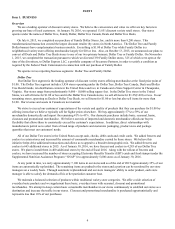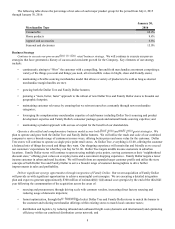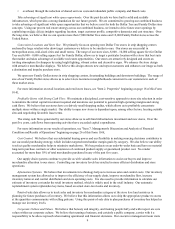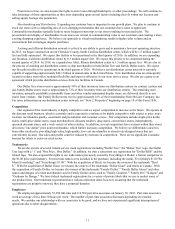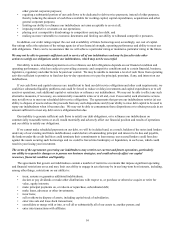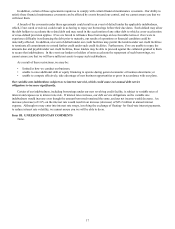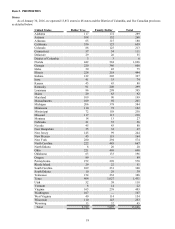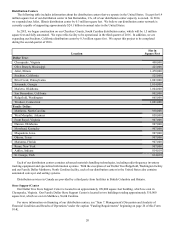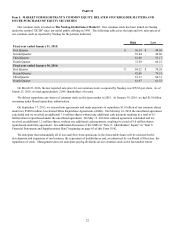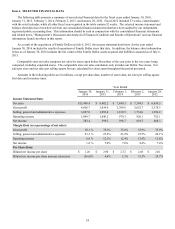Dollar Tree 2015 Annual Report Download - page 30
Download and view the complete annual report
Please find page 30 of the 2015 Dollar Tree annual report below. You can navigate through the pages in the report by either clicking on the pages listed below, or by using the keyword search tool below to find specific information within the annual report.14
We could encounter disruptions in our distribution network or additional costs in distributing merchandise.
Our success is dependent on our ability to transport merchandise to our distribution centers and then ship it to our stores in
a timely and cost-effective manner. We may not anticipate, respond to or control all of the challenges of operating our
receiving and distribution systems. Additionally, if a vendor fails to deliver on its commitments, we could experience
merchandise shortages that could lead to lost sales or increased costs. Some of the factors that could have an adverse effect on
our distribution network or costs are:
• Shipping disruption. Our oceanic shipping schedules may be disrupted or delayed from time to time.
• Shipping costs. We could experience increases in shipping rates imposed by the trans-Pacific ocean carriers. Changes
in import duties, import quotas and other trade sanctions could increase our costs.
• Efficient Operations. Distribution centers and other aspects of our distribution network are difficult to operate
efficiently and we could experience a reduction in operating efficiency.
• Diesel fuel costs. We have experienced volatility in diesel fuel costs over the past few years.
• Vulnerability to natural or man-made disasters. A fire, explosion or natural disaster at a port or any of our distribution
facilities could result in a loss of merchandise and impair our ability to adequately stock our stores. Some facilities are
vulnerable to earthquakes, hurricanes or tornadoes.
• Labor disagreement. Labor disagreements, disruptions or strikes may result in delays in the delivery of merchandise
to our distribution centers or stores and increase costs.
• War, terrorism and other events. War and acts of terrorism in the United States, the Middle East, or in China or other
parts of Asia, where we buy a significant amount of our imported merchandise, could disrupt our supply chain or
increase our transportation costs.
• Economic conditions. Suppliers may encounter financial or other difficulties.
Our profitability is affected by the mix of products we sell.
Our gross profit margin could decrease if we increase the proportion of higher cost goods we sell in the future. In recent
years, the percentage of our sales from higher cost consumable products has increased and we can give no assurance that this
trend will not continue. As a result, our gross profit margin could decrease unless we are able to maintain our current
merchandise cost sufficiently to offset any decrease in our product margin percentage. We can give no assurance that we will
be able to do so.
In our Family Dollar segment, our success also depends on our ability to select and obtain sufficient quantities of relevant
merchandise at prices that allow us to sell such merchandise at profitable and appropriate prices. A sales price that is too high
causes products to be less attractive to our customers and our sales at Family Dollar could suffer. We are continuing to
implement our everyday low price strategy at Family Dollar to drive customer loyalty and have a strategic pricing team to
improve our value and to increase profitability. Inability to successfully implement our pricing strategies at Family Dollar
could have a negative effect on our business.
In addition, our Family Dollar segment has a substantial number of private brand items and the number of items has been
increasing. We believe our success in maintaining broad market acceptance of our private brands depends on many factors,
including our pricing, costs, quality and customer perception. We may not achieve or maintain our expected sales for our
private brands and, as a result, our business and results of operations could be adversely impacted. Additionally, the increased
number of private brands could negatively impact our existing relationships with our non-private brand suppliers.
Pressure from competitors may reduce our sales and profits.
The retail industry is highly competitive. The marketplace is highly fragmented as many different retailers compete for
market share by utilizing a variety of store formats and merchandising strategies. We expect competition to increase in the
future. There are no significant economic barriers for others to enter our retail sector. Some of our current or potential
competitors have greater financial resources than we do. We cannot guarantee that we will continue to be able to compete
successfully against existing or future competitors. Please see "Item 1. Business" beginning on page 6 of this Form 10-K for
further discussion of the effect of competition on our operations.
Litigation may adversely affect our business, financial condition and results of operations.
Our business is subject to the risk of litigation involving employees, consumers, suppliers, competitors, shareholders,
government agencies, or others through private actions, class actions, governmental investigations, administrative proceedings,
regulatory actions or other litigation. Our products could also cause illness or injury, harm our reputation, and subject us to
litigation. For example, we are currently defendants in national and state employment-related class and collective actions,
litigation concerning injury from products and a governmental investigation by the Consumer Products Safety Commission.




